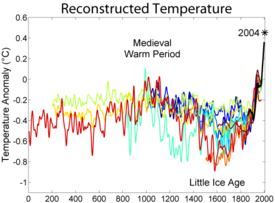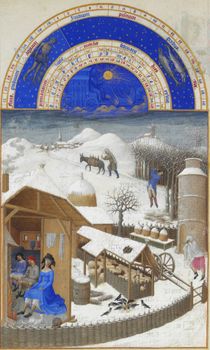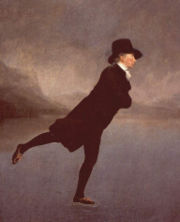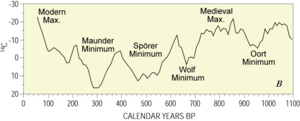Little Ice Age
2008/9 Schools Wikipedia Selection. Related subjects: Climate and the Weather
The Little Ice Age (LIA) was a period of cooling occurring after a warmer era known as the Medieval climate optimum. Climatologists and historians find it difficult to agree on either the start or end dates of this period. Some confine the Little Ice Age to approximately the 16th century to the mid 19th century. It is generally agreed that there were three minima, beginning about 1650, about 1770, and 1850, each separated by slight warming intervals.
It was initially believed that the LIA was a global phenomenon; it is now less clear if this is true. The Intergovernmental Panel on Climate Change (IPCC), based on Bradley and Jones, 1993; Hughes and Diaz, 1994; Crowley and Lowery, 2000 describes the LIA as "a modest cooling of the Northern Hemisphere during this period of less than 1°C," and says, "current evidence does not support globally synchronous periods of anomalous cold or warmth over this timeframe, and the conventional terms of 'Little Ice Age' and Medieval Warm Period appear to have limited utility in describing trends in hemispheric or global mean temperature changes in past centuries." There is evidence, however, that the Little Ice Age did affect the Southern Hemisphere.
Dating of the Little Ice Age
There is no agreed beginning year to the Little Ice Age, although there is a frequently referenced series of events preceding the known climatic minima. Starting in the 13th century, pack ice began advancing southwards in the North Atlantic, as did glaciers in Greenland. The three years of torrential rains beginning in 1315 ushered in an era of unpredictable weather in Northern Europe which did not lift until the 19th century. There is anecdotal evidence of expanding glaciers almost worldwide. In contrast, a climate reconstruction based on glacial length shows no great variation from 1600 to 1850, though it shows strong retreat thereafter.
For this reason, any of several dates ranging over 400 years may indicate the beginning of the Little Ice Age:
- 1250 for when Atlantic pack ice began to grow
- 1300 for when warm summers stopped being dependable in Northern Europe
- 1315 for the rains and Great Famine of 1315-1317
- 1550 for theorized beginning of worldwide glacial expansion
- 1650 for the first climatic minimum
In contrast to its uncertain beginning, there is a consensus that the Little Ice Age ended in the mid-19th century.
Northern hemisphere
The Little Ice Age brought bitterly cold winters to many parts of the world, but is most thoroughly documented in Europe and North America. In the mid-17th century, glaciers in the Swiss Alps advanced, gradually engulfing farms and crushing entire villages. The River Thames and the canals and rivers of the Netherlands often froze over during the winter, and people skated and even held frost fairs on the ice. The first Thames frost fair was in 1607; the last in 1814, although changes to the bridges and the addition of an embankment affected the river flow and depth, hence the possibility of freezes. The freeze of the Golden Horn and the southern section of the Bosphorus took place in 1622. In 1658 a Swedish army marched across Øresund to Denmark and invaded Copenhagen. The winter of 1794/1795 was particularly harsh when the French invasion army under Pichegru could march on the frozen rivers of the Netherlands, whilst the Dutch fleet was fixed in the ice in Den Helder harbour. In the winter of 1780, New York Harbour froze, allowing people to walk from Manhattan to Staten Island. Sea ice surrounding Iceland extended for miles in every direction, closing that island's harbors to shipping.
The severe winters affected human life in ways large and small. The population of Iceland fell by half, but this was perhaps also due to fluorosis caused by the eruption of the volcano Laki in 1783. The Viking colonies in Greenland died out (in the 15th century) because they could no longer grow enough food there. In North America, American Indians formed leagues in response to food shortages.
One researcher noted that, in many years, "snowfall was much heavier than recorded before or since, and the snow lay on the ground for many months longer than it does today." Many springs and summers were outstandingly cold and wet, although there was great variability between years and groups of years. Crop practices throughout Europe had to be altered to adapt to the shortened, less reliable growing season, and there were many years of death and famine (such as the Great Famine of 1315-1317, although this may have been before the LIA proper). Viticulture entirely disappeared from some northern regions. Violent storms caused massive flooding and loss of life. Some of these resulted in permanent losses of large tracts of land from the Danish, German, and Dutch coasts.
The extent of mountain glaciers had been mapped by the late 19th century. In both the north and the south temperate zones of our planet, snowlines (the boundaries separating zones of net accumulation from those of net ablation) were about 100 m lower than they were in 1975. In Glacier National Park, the last episode of glacier advance came in the late 18th and early 19th century. In Chesapeake Bay, Maryland, large temperature excursions during the Little Ice Age (~1400–1900 AD) and the Medieval Warm Period (~800–1300 AD) possibly related to changes in the strength of North Atlantic thermohaline circulation.
In Ethiopia and Mauritania, permanent snow was reported on mountain peaks at levels where it does not occur today. Timbuktu, an important city on the trans-Saharan caravan route, was flooded at least 13 times by the Niger River; there are no records of similar flooding before or since. In China, warm weather crops, such as oranges, were abandoned in Jiangxi Province, where they had been grown for centuries. In North America, the early European settlers also reported exceptionally severe winters. For example, in 1607-1608 ice persisted on Lake Superior until June.
Antonio Stradivari, the famous violin maker, produced his instruments during the LIA. It has been proposed that the colder climate caused the wood used in his violins to be denser than in warmer periods, contributing to the tone of Stradivari's instruments.
The Little Ice Age by anthropology professor Brian Fagan of the University of California at Santa Barbara, tells of the plight of European peasants during the 1300 to 1850 chill: famines, hypothermia, bread riots, and the rise of despotic leaders brutalizing an increasingly dispirited peasantry. In the late 17th century, writes Fagan, agriculture had dropped off so dramatically that "Alpine villagers lived on bread made from ground nutshells mixed with barley and oat flour." Finland lost perhaps a third of its population to starvation and disease.
Depictions of winter in European painting
Burroughs (Weather, 1981) analyses the depiction of winter in paintings. He notes that this occurred almost entirely from 1565 to 1665, and was associated with the climatic decline from 1550 onwards. He claims (quite wrongly) that before this there were almost no depictions of winter in art, and hypotheses that the unusually harsh winter of 1565 inspired great artists to depict highly original images, and the decline in such paintings was a combination of the "theme" having been fully explored, and mild winters interrupting the flow of painting.
The famous winter paintings by Pieter Brueghel the Elder (e.g. Hunters in the Snow) all appear to have been painted in 1565. Snow also dominates many village-scapes by the Pieter Brueghel the Younger, who lived from 1564 to 1638. Burroughs states that Pieter Brueghel the Younger "slavishly copied his father's designs. The derivative nature of so much of this work makes it difficult to draw any definite conclusions about the influence of the winters between 1570 and 1600...".
Dutch painting of the theme appears to begin with Hendrick Avercamp after the winter of 1608. There is then an interruption of the theme between 1627 and 1640, with a sudden return thereafter; this hints at a milder interlude in the 1630s. The 1640s to the 1660s cover the major period of Dutch winter painting, which fits with the known proportion of cold winters then. The final decline in winter painting, around 1660, does not coincide with an amelioration of the climate; Burroughs therefore cautions against trying to read too much into artistic output, since fashion plays a part. He notes that winter painting recurs around the 1780s and 1810s, which again marked a colder period.
Scottish painting and contemporary records demonstrate that curling and skating were formerly popular outdoor winter sports, but it is now seldom possible to curl outdoors in Scotland due to unreliable conditions. The revival of interest in painting such scenes as Raeburn's Skating Minister may owe as much to the romantic movement, which favoured depictions of dramatic landscapes, as to any meaningful observation on climate.
Southern hemisphere
An ocean sediment core from the eastern Bransfield Basin in the Antarctic Peninsula shows centennial events that the authors link to the Little Ice Age and Medieval Warm Period. The authors note "other unexplained climatic events comparable in duration and amplitude to the LIA and MWP events also appear." The LIA is easily distinguished in the Quelccaya Ice Cap (Peruvian Andes, South America).
The Siple Dome (SD) has a climate event with an onset time that is coincident with that of the LIA in the North Atlantic based on a correlation with the GISP2 record. This event is the most dramatic climate event seen in the SD Holocene glaciochemical record. The Siple Dome ice core also contained its highest rate of melt layers (up to 8%) between 1550 and 1700, most likely due to warm summers during the LIA.
Law Dome ice cores show lower levels of CO2 mixing ratios during 1550-1800 AD, probably as a result of colder global climate.
Sediment cores (Gebra-1 and Gebra-2) in Bransfield Basin, Antarctic Peninsula, have neoglacial indicators by diatom and sea-ice taxa variations during the period of the LIA.
In 1836, snow fell in the city centre of Sydney, Australia, the only time since European settlement in 1788 that this has occurred.
Tropical Pacific coral records indicate the most frequent, intense El Niño-Southern Oscillation activity occurred in the mid 17th century, during the Little Ice Age.
Climate patterns
In the North Atlantic, sediments accumulated since the end of the last ice age, nearly 12,000 years ago, show regular increases in the amount of coarse sediment grains deposited from icebergs melting in the now open ocean, indicating a series of 1-2°C (2-4°F) cooling events recurring every 1,500 years or so. The most recent of these cooling events was the Little Ice Age. These same cooling events are detected in sediments accumulating off Africa, but the cooling events appear to be larger, ranging between 3-8°C (6-14°F).
Causes
Scientists have identified two causes of the Little Ice Age from outside the ocean/atmosphere/land systems: decreased solar activity and increased volcanic activity. Research is ongoing on more ambiguous influences such as internal variability of the climate system, and anthropogenic influence (Ruddiman). Ruddiman has speculated that depopulation of Europe, East Asia, and the Middle East during the Black Death, with the resulting decrease in agricultural output and reforestation taking up more carbon from the atmosphere, may have prolonged the Little Ice Age. Ruddiman further speculates that massive depopulation in the Americas after the European contact in the early 1500s had similar effects.
One of the difficulties in identifying the causes of the Little Ice Age is the lack of consensus on what constitutes "normal" climate. While some scholars regard the LIA as an unusual period caused by a combination of global and regional changes, other scientists see glaciation as the norm for Earth and the Medieval Warm Period (as well as the Holocene interglacial period) as the anomalies requiring explanation.
Solar activity
During the period 1645–1715, in the middle of the Little Ice Age, there was a period of low solar activity known as the Maunder Minimum. The physical link between low sunspot activity and cooling temperatures has not been established, but the coincidence of the Maunder Minimum with the deepest trough of the Little Ice Age is suggestive of such a connection. The Spörer Minimum has also been identified with a significant cooling period near the beginning of the Little Ice Age. Other indicators of low solar activity during this period are levels of the isotopes carbon-14 and beryllium-10.
Volcanic activity
Throughout the Little Ice Age, the world also experienced heightened volcanic activity. When a volcano erupts, its ash reaches high into the atmosphere and can spread to cover the whole of Earth. This ash cloud blocks out some of the incoming solar radiation, leading to worldwide cooling that can last up to two years after an eruption. Also emitted by eruptions is sulfur in the form of SO2 gas. When this gas reaches the stratosphere, it turns into sulfuric acid particles, which reflect the sun's rays, further reducing the amount of radiation reaching Earth's surface. The 1815 eruption of Tambora in Indonesia blanketed the atmosphere with ash; the following year, 1816, came to be known as the Year Without A Summer, when frost and snow were reported in June and July in both New England and Northern Europe.
Ocean Conveyor Shutdown
Another possibility is that there was a shutdown or slowing of Thermohaline circulation, also known as the "great ocean conveyer" or "meridional overturning circulation". The Gulf Stream could have been interrupted by the introduction of a large amount of fresh water to the North Atlantic, possibly caused by a period of warming before the little ice age. There is some concern that shutdown of thermohaline circulation could happen again as a result of global warming .
End of Little Ice Age
Beginning around 1850, the climate began warming and the Little Ice Age ended. Some global warming critics believe that Earth's climate is still recovering from the Little Ice Age and that human activity is not the decisive factor in present temperature trends, but this idea is not widely accepted. Instead, mainstream scientific opinion on climate change is that warming over the last 50 years is caused primarily by the increased proportion of CO2 in the atmosphere caused by human activity. There is less agreement over the warming from 1850 to 1950.



